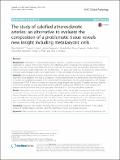The study of calcified atherosclerotic arteries: an alternative to evaluate the composition of a problematic tissue reveals new insight including metakaryotic cells
Author(s)
Fittipaldi, Silvia; Vasuri, Francesco; Degiovanni, Alessio; Pini, Rodolfo; Gargiulo, Mauro; Stella, Andrea; Pasquinelli, Gianandrea; Thilly, William G.; Gostjeva, Elena V.; ... Show more Show less
Download12907_2016_Article_36.pdf (3.808Mb)
PUBLISHER_CC
Publisher with Creative Commons License
Creative Commons Attribution
Terms of use
Metadata
Show full item recordAbstract
Background
Calcifications of atherosclerotic plaques represent a controversial issue as they either lead to the stabilization or rupture of the lesion. However, the cellular key players involved in the progression of the calcified plaques have not yet been described. The primary reason for this lacuna is that decalcification procedures impair protein and nucleic acids contained in the calcified tissue. The aim of our study was to preserve the cellular content of heavily calcified plaques with a new rapid fixation in order to simplify the study of calcifications.
Methods
Here we applied a fixation method for fresh calcified tissue using the Carnoy’s solution followed by an enzymatic tissue digestion with type II collagenase. Immunohistochemistry was performed to verify the preservation of nuclear and cytoplasmic antigens. DNA content and RNA preservation was evaluated respectively with Feulgen staining and RT-PCR. A checklist of steps for successful image analysis was provided. To present the basic features of the F-DNA analysis we used descriptive statistics, skewness and kurtosis. Differences in DNA content were analysed with Kruskal-Wallis and Dunn’s post tests. The value of P < 0.05 was considered significant.
Results
Twenty-four vascular adult tissues, sorted as calcified (14) or uncalcified (10), were processed and 17 fetal tissues were used as controls (9 soft and 8 hard). Cells composing the calcified carotid plaques were positive to Desmin, Vimentin, Osteocalcin or Ki-67; the cellular population included smooth muscle cells, osteoblasts and osteoclasts-like cells and metakaryotic cells. The DNA content of each cell type found in the calcified carotid artery was successfully quantified in 7 selected samples. Notably the protocol revealed that DNA content in osteoblasts in fetal control tissues exhibits about half (3.0 ng) of the normal nuclear DNA content (6.0 ng).
Conclusion
Together with standard histology, this technique could give additional information on the cellular content of calcified plaques and help clarify the calcification process during atherosclerosis.
Date issued
2016-07Department
Massachusetts Institute of Technology. Laboratory in Metakaryotic Biology; Massachusetts Institute of Technology. Department of Biological EngineeringJournal
BMC Clinical Pathology
Publisher
BioMed Central
Citation
Fittipaldi, Silvia et al. “The Study of Calcified Atherosclerotic Arteries: An Alternative to Evaluate the Composition of a Problematic Tissue Reveals New Insight Including Metakaryotic Cells.” BMC Clinical Pathology 16.1 (2016): n. pag.
Version: Final published version
ISSN
1472-6890